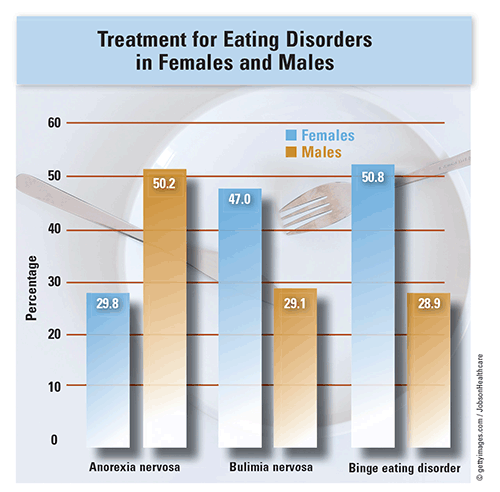US Pharm. 2020;45(5):12.
According to the National Institute of Mental Health, eating disorders are serious conditions that can sometimes result in death. Surveys have shown that 20 million women and 10 million men will have an eating disorder at some point in their life. Common eating disorders include binge eating disorder (BED), bulimia nervosa (BN), and anorexia nervosa (AN). Studies have shown that 50% to 80% of the risk for AN, BN, and BED is genetic. Eating disorders have the highest mortality rates of all mental illnesses, according to one study.

Prevalence of Eating Disorders: The lifetime prevalence of BED, BN, and AN among adults has been reported to be 2.8%, 1%, and 0.6%, respectively. Eating disorders were more than twice as prevalent in females (3.8%) than in males (1.5%). More than one-half (56.2%) of survey respondents with AN, 94.5% of those with BN, and 78.9% of those with BED met criteria for at least one eating disorder. The prevalence of eating disorders increased modestly with age.
Characteristics of Comorbidity: All three eating disorders had the highest comorbidity with anxiety disorder. Two-thirds of people with AN showed signs of an anxiety disorder several years before the eating disorder manifested. BN was the most prevalent comorbid eating disorder in patients with anxiety disorder (80.6%), mood disorder (70.7%), impulse-control disorder (63.8%), and substance-use disorder (36.8%). BED was the second most frequent comorbidity in patients with anxiety disorder (65.1%), mood disorder (46.4%), impulse-control disorder (43.3%), and substance-use disorder (27%). AN was the third most prevalent comorbid eating disorder in patients with anxiety disorder (47.9%), mood disorder (42.1%), impulse-control disorder (30.8%), and substance-use disorder (23.3%). Of the 56% of adults diagnosed with anxiety disorder, 22% already had an alcohol-use or substance-use disorder. In a study of women with eating disorders, 94% had a co-occurring mood disorder and 92% had a depressive disorder.
Treatment Trends: Most adults with AN, BN, and BED (50%-63.2%) received treatment for emotional problems at some time in their life. For eating disorders, 33.8%, 43.2%, and 43.6% of adults with AN, BN, and BED, respectively, sought treatment. Females with BN and BED sought treatment more often (62% and 76%, respectively) than males did; however, in the case of AN, men more often sought treatment (68%). Among females with eating disorders, 50.8%, 47%, and 29.8% were treated for BED, BN, and AN, respectively. Among males, rates of treatment were in reverse order (50.2%, 29.1%, and 28.9% for AN, BN, and BED, respectively).
The content contained in this article is for informational purposes only. The content is not intended to be a substitute for professional advice. Reliance on any information provided in this article is solely at your own risk.
To comment on this article, contact rdavidson@uspharmacist.com.





